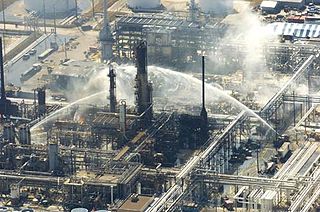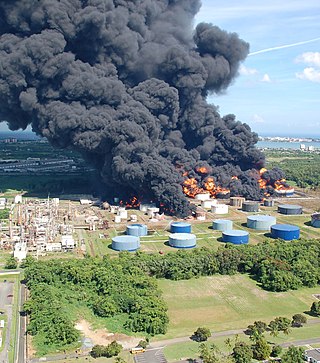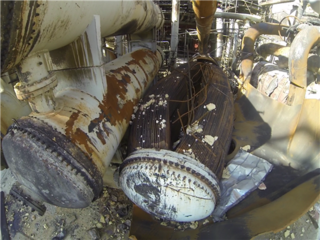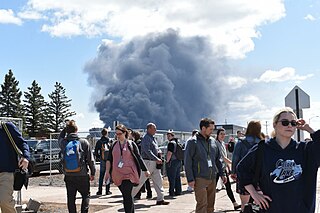A chemical accident is the unintentional release of one or more chemical hazard substances which could harm human health and the environment. Such events include fires, explosions, leakages or release of toxic or hazardous materials that can cause people illness, injury, or disability. Chemical accident can be caused by natural disaster, or accidental human error, or deliberate move to cause chaos and destructions for personal gain.

The Texas City Refinery explosion occurred on March 23, 2005, when a vapor cloud of natural gas and petroleum ignited and violently exploded at the isomerization (ISOM) process unit at the BP Texas City refinery in Texas City, Texas, killing 15 workers, injuring 180 others and severely damaging the refinery. The Texas City Refinery was the second-largest oil refinery in the state, and the third-largest in the United States with an input capacity of 437,000 barrels (69,500 m3) per day as of January 1, 2000. BP acquired the Texas City refinery as part of its merger with Amoco in 1999.
The West Pharmaceutical Plant explosion was an industrial disaster that occurred on January 29, 2003 at the West Pharmaceutical Plant in Kinston, North Carolina, United States. Six people were killed and thirty-six people were injured when a large explosion ripped through the facility. Two firefighters were injured in the subsequent blaze. The disaster occurred twelve years and 170 miles (270 km) from the 1991 Hamlet chicken processing plant fire, North Carolina's second-worst industrial disaster.

The T2 Laboratories explosion and fire occurred on December 19, 2007, in Jacksonville, Florida, resulting in the deaths of four people and the injury of fourteen others. T2 Laboratories Inc. was a facility that specialized in the design and manufacture of specialty chemicals primarily for gasoline additives.

The 2008 Georgia sugar refinery explosion was an industrial disaster that occurred on February 7, 2008, in Port Wentworth, Georgia, United States. Fourteen people were killed and forty injured when a dust explosion occurred at a sugar refinery owned by Imperial Sugar. Dust explosions had been an issue of concern among U.S. authorities since three fatal accidents in 2003, with efforts made to improve safety and reduce the risk of reoccurrence.
The Xcel Energy Cabin Creek Fire occurred on October 2, 2007, at Xcel Energy’s pumped storage hydroelectric plant near Georgetown, Colorado, a small town forty-five miles west of Denver. The accident killed five workers and injured three. The incident is thought to be the result of botched work by a contractor and Xcel Energy's willingness to cut costs at the expense of safety.

The Chevron Richmond Refinery is a 2,900-acre (1,200 ha) petroleum refinery in Richmond, California, on San Francisco Bay. It is owned and operated by Chevron Corporation and employs more than 1,200 workers, making it the city's largest employer. The refinery processes approximately 240,000 barrels (38,000 m3) of crude oil a day in the manufacture of petroleum products and other chemicals. The refinery's primary products are motor gasoline, jet fuel, diesel fuel and lubricants.

The 2009 Cataño oil refinery fire was a fire that began with an explosion on October 23, 2009, and was extinguished on October 25 at the Caribbean Petroleum Corporation (CAPECO) oil refinery and oil depot in Bayamón, Puerto Rico. While the fire and subsequent explosion occurred close to the city of Cataño, it technically occurred within the borders of Bayamón, even though Cataño was more affected by fumes and evacuation. There were no fatalities, but 3 people were injured.

On April 17, 2013, an ammonium nitrate explosion occurred at the West Fertilizer Company storage and distribution facility in West, Texas, United States, while emergency services personnel were responding to a fire at the facility. Fifteen people were killed, more than 160 were injured, and more than 150 buildings were damaged or destroyed. Investigators confirmed that ammonium nitrate was the material that exploded. On May 11, 2016, the Bureau of Alcohol, Tobacco, Firearms and Explosives stated that the fire had been deliberately set. That finding has been disputed.

The Williams Olefins Plant explosion occurred on June 13, 2013 at a petrochemical plant located in Geismar, an unincorporated and largely industrial area 20 miles (32 km) southeast of Baton Rouge, Louisiana. Two workers were killed and 114 injured. The U.S. Occupational Safety and Health Administration (OSHA) and the U.S. Chemical Safety and Hazard Investigation Board (CSB) launched investigations to determine how and why the heat exchanger failed. The Chemical Safety Board concluded that a standby heat exchanger had filled with hydrocarbon. This heat exchanger was isolated from its pressure relief; shortly after the heat exchanger was heated with hot water, the hydrocarbon flashed to vapor, ruptured the heat exchanger, and exploded.

Rafael Moure-Eraso is a former chairman and chief executive of the U.S. Chemical Safety and Hazard Investigation Board (CSB).
The Journal of System Safety (JSS) is a peer-reviewed scientific journal published by the International System Safety Society three times per year. The journal was established in 1965 as Hazard Prevention and obtained its current name in 1999. JSS is considered one of the important journals in the field of reliability and safety and is one of the oldest in continuous publication.

The 2010 Tesoro Anacortes Refinery disaster was an industrial accident that occurred at the Tesoro Anacortes Refinery in Anacortes, Washington on April 2, 2010. Seven workers received fatal burns in an explosion and ensuing fire when a heat exchanger violently ruptured after a maintenance restart.
Chemicals as elements, compounds, mixtures, solutions and emulsions are very widely used and transported in the modern industrial society. Of necessity, they are also used in schools, universities and other training facilities to educate pupils in their safe use and handling and also are commonly used in domestic situations for cleaning, gardening and DIY. However, there are chemicals that should not mix or get in contact with others, as they can produce byproducts that may be toxic, carcinogenic, explosive etc, or can be dangerous themselves. To avoid disasters and mishaps, maintaining safety is considered paramount, especially by chemists.

Vanessa Lorraine Allen Sutherland is a corporate lawyer and former chairperson of the U.S. Chemical Safety and Hazard Investigation Board (CSB).

Katherine Andrea Lemos is an American safety professional and the former chairperson and CEO of the U.S. Chemical Safety and Hazard Investigation Board (CSB).
An explosion at the ARCO Chemical (ACC) Channelview, Texas petrochemical plant killed 17 people and injured five others on July 5, 1990. It was one of the deadliest industrial disasters in the history of the Greater Houston area.

On April 26, 2018, an explosion and subsequent fire occurred at the Husky Energy Oil Refinery in Superior, Wisconsin. An initial explosion was reported at 10:00 AM and was extinguished close to noon, however a piece of debris had hit a storage tank containing asphalt, which ignited after spilling across the refinery, sending a thick plume of black smoke into the air. Thirty-six people, including 11 refinery employees, were sent to local hospitals, but there were ultimately no fatalities. Residents 3 miles to the east and west of the refinery, 2 miles to the north, and 10 miles to the south were evacuated from their homes temporarily due to concerns of both the toxicity of the smoke affecting those who lived south of the refinery and concerns regarding the plant's hydrofluoric acid tank causing further damage.

On June 21, 2019, the Philadelphia Energy Solutions refinery in Philadelphia, Pennsylvania was the place of an explosion and fire early morning, when a release of hydrocarbons and hydrofluoric acid in the refinery's alkylation unit caused a ground-hugging vapor cloud which rapidly ignited, leading to three separate explosions minutes apart from each other. The largest explosion sent a vessel fragment flying 2,000 feet across the Schuylkill River. Five employees sustained minor injuries, but there were ultimately no reported fatalities. The refinery announced it would shut down operations the same month, and filed for bankruptcy a month later.














